God's box Ladybug. Description of the insect with photos and video
Ladybugs are small insects, well known for their bright color and lack of fear in front of man.
Most people know the seven-point ladybug, but the species diversity of these insects is enormous. There are 5,200 species of ladybirds in the world, allocated to the same-named family in the Coleoptera unit. Thus, numerous species of beetles are relatives of ladybirds. 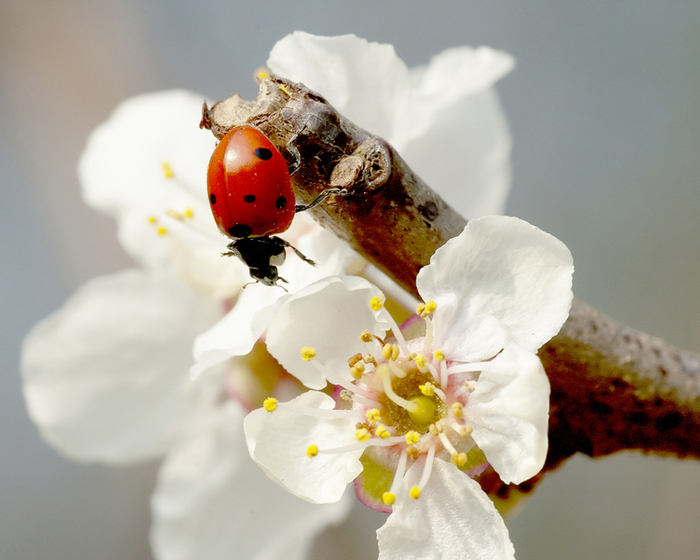
Seven-point ladybug (Coccinella septempunctata).
The dimensions of ladybirds are small, in length they reach 4-9 mm. They are characterized by a very small head, an enlarged cephalothorax and a rounded or weakly extended body with rigid convex elytra. The color of most species is very bright - red with black dots, the number of which in different species can vary from 2 to 22. At the same time, among the ladybirds there are species with orange and yellow elytra, with dots of not only black but also white. For example, the rather ordinary double-headed ladybug is distinguished by a strong variability of color. 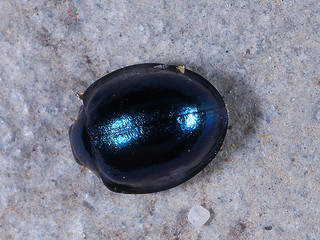
The blue ladybug (Halmus chalybeus) has an elytra with bright metallic luster.
In some individuals, it is red with black dots, in others, these dots have become irregularly shaped spots, in others, the color is inverted, black with red spots. Less common among ladybirds come across monochrome species of black color. 
Ladybirds are spread all over the world and are found on all continents except Antarctica. These beetles are populated with open spaces with grassy vegetation - meadows, forest edges, gardens, steppes, less often dense forests. They live alone, clusters form only during wintering. Usually, ladybugs crawl over plant stalks in search of food, but also willingly fly over significant distances.
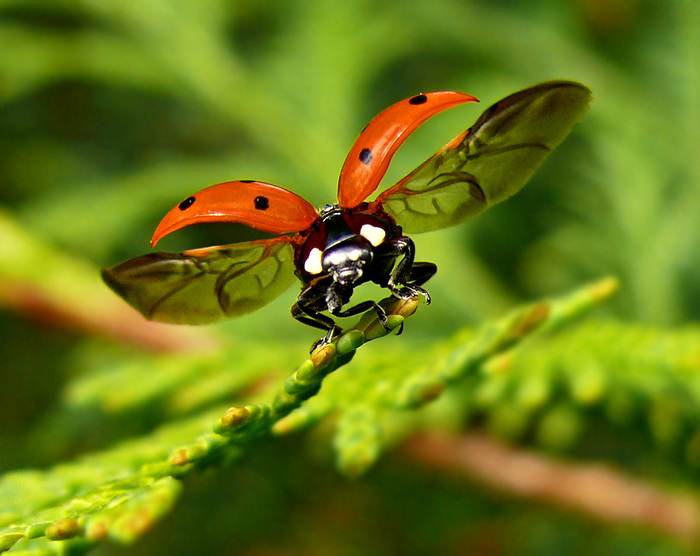
Their flight is easy, fast and completely silent. Forms of the temperate zone for winter fall into a stupor, for this they form clusters in the fall and hide under stones or in foliage. ![]()
Ladybug in flight.
The vast majority of the ladybirds are insatiable predators and only a few species are herbivorous. Herbivorous ladybugs feed on a narrow set of plants, for example, the epilahna Argus ladybug eats exclusively the leaves of bryony dioecious (stepping stone). Predatory ladybugs are extremely voracious and can eat a day up to hundreds of small insects - aphids, spider mites, worms, whiteflies, and they hunt not only adults, but also eat their larvae and eggs. Occasionally, ladybugs can even attack butterfly caterpillars. The victims of ladybirds are immobile, so the hunt for them comes down to simply eating the victim. 
Seven-point ladybug eats aphids.
Ladybirds multiply several times a year, temperate belt species begin to breed in May. The female lays small yellow eggs on the stalks or the reverse side of the leaves. Females of different species can lay from 200-400 to 1500 eggs. 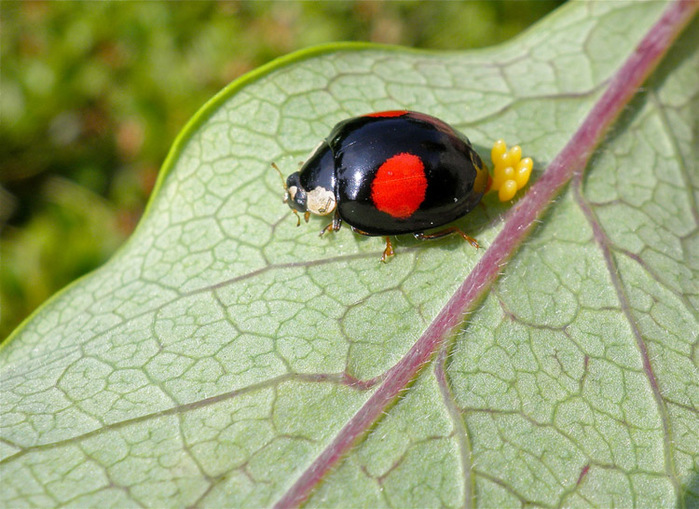
A double ladybug (Adalia bipunctata) lays eggs.
Ladybirds try to lay their eggs next to clusters of victims (aphids), and the rhodium ladybug directly on its sac's egg sacks is a worm. Thus, the larvae of ladybirds from the first minutes of life are provided with food, however, finding food is easy for them, since the larvae are mobile and run fast. The larvae are small, with an elongated jointed calf, in some species there may be branchy outgrowths. Larvae are gray (rarely yellow) with yellow or red dots. Larvae are as voracious as their parents and can even attack prey larger than theirs. Their development lasts from 2-4 weeks to 3 months, during which time each larva can eat up to 1000 aphids. 
The larva of the world of eighteen-point (Myrrha octodecimguttata).
Ladybirds themselves have few enemies. Of course, they get "on the tooth" birds, but they have an effective means of protection. From the articulation of the paws, they emit a caustic yellow liquid with an unpleasant taste, so birds and lizards more often spit out the caught bug, rather than eat it. 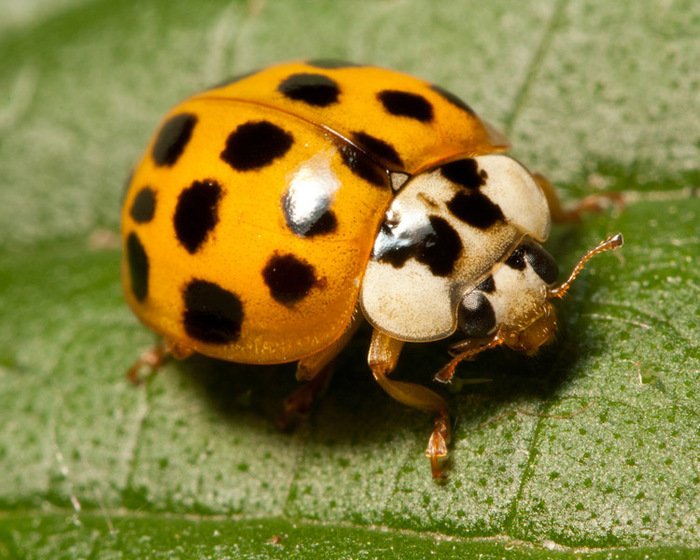
Ladybird harmony (Harmonia axyridis) of an unusual yellow color.
Among these beetles, only herbivorous potato and melon cows (living in the Far East and Central Asia, respectively) can cause damage to cultivated plants. The remaining predatory species bring undoubted benefits to humans, destroying a huge number of harmful insects. That is why ladybirds have long enjoyed the honor and love of people. For all peoples, these bugs were considered a symbol of goodness, well-being, and gullibility.

Interestingly, in 55 world languages there are 329 names of these insects, one way or another connected with the concept of God! These insects are called “ladybirds”, “god’s sheep”, “cattle of God”, etc. The English name (literally translated as "the bird of the Virgin") refers to the Virgin Mary. And this connection arose thanks to seven dots on the back of the most common type - a seven-point ladybug.
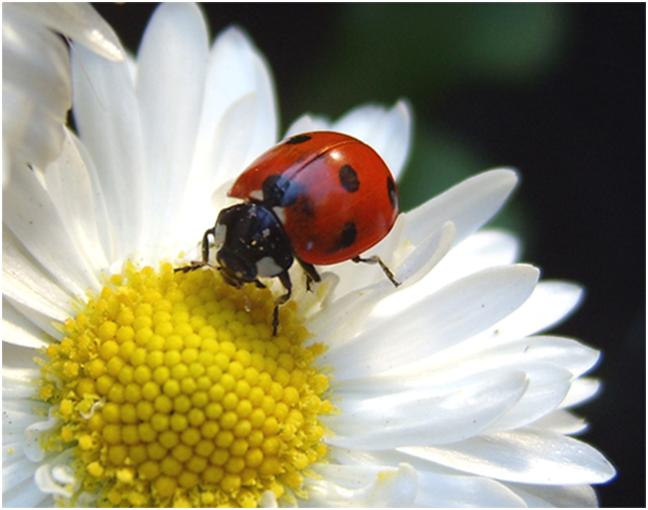
The British interpreted the red color of the ladybird as a reminder of the passions of Christ, and the seven black dots associated it with the seven sorrows of the Mother of God. Ladybirds were a favorite object of children's folklore, because they willingly sit on hands and clothes, and are available for observation even to the smallest naturalists. 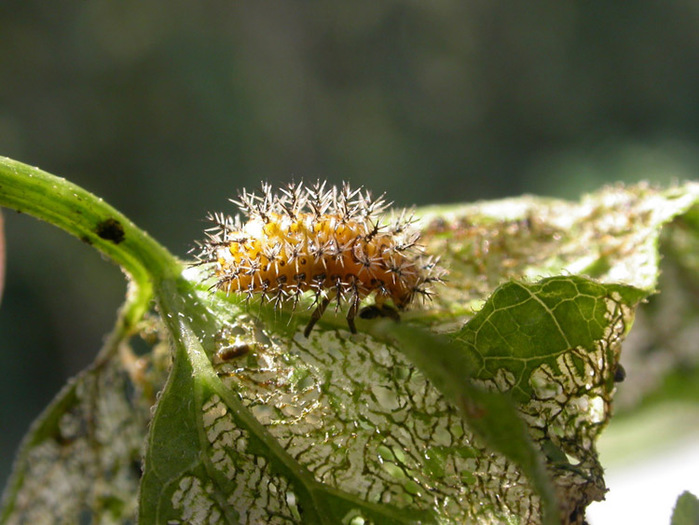
The larva of the herbivorous epilukhna argus (Epilachna argus) eats a leaf of bryonia.
Now these peaceful and beautiful beetles continue to serve people. Ladybirds are used on an industrial scale to control pests of agricultural crops: rhodolium is used to destroy the Australian trench-fed worm on citrus plantations, and Lindoru cow is used to destroy shield insects in fruit orchards.

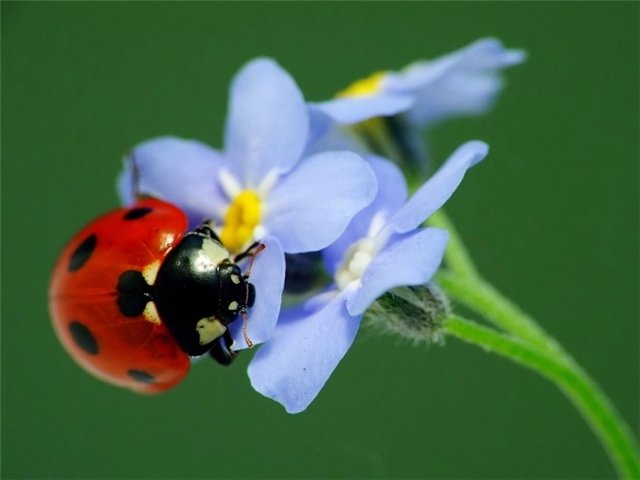
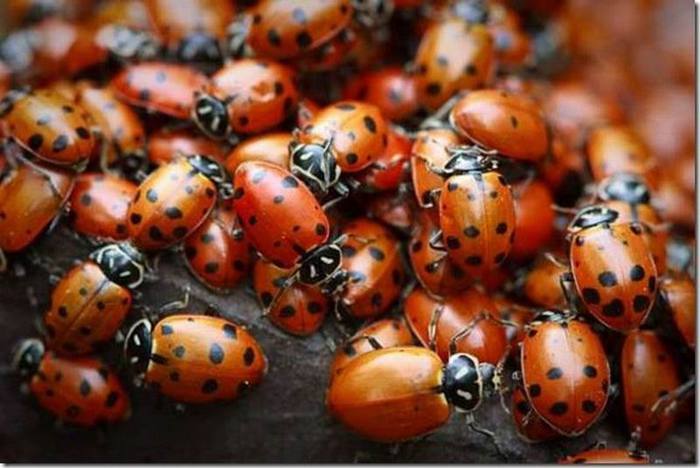
In different countries, this bug is called differently, but in his name always shows the deep respect of the people for a small insect. In England, he is called the "lady-bug", in Ukraine - the "sun", and in Russia and, by the way, in France, too - "ladybug". Why ladybug? Probably because the bug, when frightened, releases hemolymph from the joints of the paws, a whitish substance, similar in appearance (but not to taste!) To milk. And it is called God's because of the great benefits that it brings to our gardens, vineyards and gardens. Have you ever wondered what ladybugs eat?
Here she slowly crawls on a blade of grass: red, like a half of a lacquered ball, with seven black dots on the wings ... Stop! In fact, there are about four and a half thousand species of ladybirds all over the world. And they are not only red seven-point ones, but also yellow, white, black, orange. They are found on all continents, where there is at least some vegetation. There is a meadow and field ladybird, one that lives in trees, and even one that loves to live on aquatic plants. But the gastronomical preferences of the entire immense kingdom of “suns” are almost the same - they are soft insects.
There are, of course, malicious “suns”, and even an ordinary ladybug on a hot summer day is not averse to quenching thirst by chewing a juicy leaf. However, such harm is incomparable with the benefits that the bug brings to farmers. To trace what a ladybug eats, you need to arm yourself with a magnifying glass. It is hard to believe that this cute bug is a terrible and voracious predator, because it has a small movement speed and no capture tools, such as praying mantis, for example. But the "sun" and this is not necessary, because its production is even slower and completely defenseless.
What do ladybirds eat in winter? This migratory insect with the first night frosts begins to migrate to the mountains. There it creeps into the cracks and crevasses of the rocks. On the place of their wintering so many flies that they cover the stones with a red pattern. Sometimes in one place it accumulates up to several million individuals. In cramped situations, but not offended: the more bugs it snaps into a tiny gap, the more chances to survive the fierce mountain frosts. As soon as a large sun begins to warm the stones, small “suns” awaken from hibernation and fly out. Having eaten a little on the young grass, the bugs lay their eggs not far from the large colony of aphids to provide barely hatched offspring with food. The number of eggs depends on the food of the mother. In the clutch there are from two hundred to four hundred eggs.
After 5-8 days, small larvae appear from them. What feeds ladybugs in his childhood, which lasts about twenty days? First, the neighboring eggs, of which no one has hatched yet, to stock up on nutrients until the larva finds its main food — eggs, larvae, or adult aphids. And in their search for young "suns" are very patient and methodical - because they have no wings, like adults, to fly to places with the best food supply, and they tirelessly, meter by meter, explore the space around them.
fb.ru
Our beneficial insects, underrated pest control allies. And although they may, at first glance, seem very small, tender and defenseless, in a short period of time they can destroy surprisingly many pests.
Ladybug.
One of the most important beneficial insects in our country is the beetle, called - ladybug (lat. Coccinellidae).
This small, brightly colored predator scutes, in our country, the most numerous and under favorable conditions, can free many plants from pesky insects. Most pests eat ladybird larvae, up to the moment of becoming an adult, from 400 to 3 thousand aphids can be swallowed up, but adult ladybugs, which eat more than 200 different insects every day, have a smaller appetite. Their main food is aphid, but the ladybirds are not particularly picky and willingly take the opportunity to profit from leaflets, Hymenoptera sawflies and horntails, mites, worms and shields, or Diptera larvae. Such a serious ally can not be ignored by us, so you should take a closer look at him to create the best conditions for his life in our garden.
Types of Ladybugs
Ladybug each is associated with a small insect with a bright red shell, with several black dots. This is only one of many of his images, since there are more than 5 thousand types of ladybirds in the world, of which we have more than seventy.
The most common are of course Two point (lat. Adalia bipunctata) and Seven-point (lat. Coccinella septempunctata), with a typical red shell for us, but besides them there are also insects with orange-red shell and black dots - Ten-point, (lat. Adalia decempunctata), red shell and black dots, with a yellow rim in a circle - Mottled Cow (lat. Anatis ocellata), black shell and yellow or red dots - Fourteen spotted cow (lat. Coccinula quatuordecimpustulata), yellow or cream shell and black dots - Twenty-two-point koroovka , or psillobor , orange shell and cream points - Calvia ten spotted (lat. Calvia decemguttata).
Twenty-two-point koroovka, or psillobor
Like adult individuals, the larvae also differ among themselves, while their appearance is not at all like any of the parents. The larvae of the ladybirds are small, but at close range they look very scary, resembling small crocodiles or miniature monsters, pupae can be easily confused with the Colorado beetle. In general, the body of the larva is sectional, gray-black with yellow or orange spots, but there are species in which yellow larvae have a black speck. Because of their unusual appearance, the offspring of ladybirds can often be mistaken for pests and destroyed, therefore, before we decide to take radical measures, you should watch the insects. Interestingly, not all predators known to us are ladybirds, because some ex. Twenty-two-point cow, can feed on fungi (powdery mildew), and even plants (one of the few pests belonging to ladybugs - Alfalfa twenty-four cow (lat. Subcoccinella vigintiquatuorpunctata).
The life cycle of the development of a ladybug.
The development cycle of a ladybug is rather complicated. An adult female, after fertilization, lays oblong, yellow-orange eggs. Attaching them to different parts of plants, as a rule, closer to the power source, for example. aphid colonies. One female can lay more than 1000 eggs for a short life (about 1-1.5 years). The larvae hatch from the eggs, which then develop into pupae, and then, into an adult ladybird (from the moment of laying the eggs until the appearance of a mature insect in our climate takes about 40-60 days).
Ladybird Larva
In the fall, adult insects are looking for secluded and warm places where they can safely spend the winter. As a rule, they choose tree bark, stones, composting, piles of leaves or needles, but sometimes they can also hide in window crevices or window sills, but in such a shelter they rarely wait for spring, because they usually dry out.
Ladybug on the plot.
ladybug the insect is independent and it is difficult to predict where it will decide to settle, therefore, if we want to have it in our garden, we should try a little. First of all, we should not use any chemical plant protection products in the country or choose those that are not harmful to the ladybirds. In addition, it is necessary to allocate a small space in the garden, in which we will not interfere (we stop mowing the grass, raking the leaves).
Thus, we create a favorable environment not only for the ladybirds, but also for many useful insects, such as the golden-eyed, spiders and ants, which in such a place can freely reproduce, develop, and hibernate. If such a wild nook will spoil the view of the garden, you can close it with a decorative wooden fence or an original fence.
Remarkably, these inconspicuous insects also have their secret weapon to protect against enemies. Feeling dangerous, they emit a yellow, unpleasant smell, a substance that should scare off the enemy.
The reputation of our allies, in recent years has been slightly "stained", because of one of its relatives Harmonia axyridis, the people - " Asian ladybug". It is more aggressive and reproduces faster than ours, “domestic”, therefore it represents a greater threat to them. It happens that an Asian ladybug bites people, causing an unpleasant burning sensation at the site of the bite, and sometimes allergies. And although this species is really annoying and alien to us, it should not affect the reputation of the whole genus, these beautiful and useful insects.
If you have something to add, please be sure to leave your comment on the site.
YOU MUST ALSO LIKE ...
- Aphids in the garden. Aphids - how does it look and how to fight it? Aphid pest is very dangerous - and for the garden (trees, shrubs, flowers), and ...
- Slugs in the garden. Fighting slugs. Slugs can become a serious problem, because they are probably the most voracious pests in our gardens. They can…
- Moles on the site. Fighting moles in the area. Despite the fact that the mole is very useful, harmless, and at the same time a really good creature ...
- Bees on the site Bees in the garden. The role of bees in the garden is invaluable - they pollinate ornamental flowers and many cultivated plants. Learn how to make ...
- Caring for indoor plants ... Winter for indoor plants is a difficult time: limited access of light for short and cloudy days, in our apartments is too short ...
zagorodacha.ru
is a ladybug a useful insect?
Forest
Definitely useful ... eats insects harmful to plants ... aphids. True, not all types of ladybugs are.
Wolf
elena orlova
of course, it is sold abroad and gardeners can order such a useful insect via the Internet and receive it with a package and release their
Zoya K
She eats aphids. She is helpful.
Di Sabirov
definitely useful in the garden watching a ladybug sitting on currant leaves eaten by aphids.
Serafima Arkadyevna
i fuck on both cheeks
Olga
She eats very much. We gather and plant on apple trees from the whole lot.
Zmey Gorynych
useful .... I even want to make a barn this summer ---- I saw somewhere --- I will arrange a rodeo cows with aphids and so on
Alex
By the way, ladybirds are several dozen types of different colors.
Well and get acquainted with other useful insects - http://lilygold.ru/view_post.php?id=125
Ilya
Very very helpful
Hulot
useful (from aphids)
Galia
i fished them in the garden and in the greenhouse in the spring run. I sometimes sprinkle pepper at home (I probably have to the ground). a blow no pests remain! and to myself from the hayfield from the field I caught it and brought it in a box.
what are the ladybirds for
Vakhit Shavaliev
Family of GOD-COWS (Coccinellidae) Every lady knows ladybirds. They simply can not miss. In the spring sunny days, bugs briskly fly from place to place, sit on the hands, face, clothes, then take off again. Ladybirds attract attention as a peculiar shape of their rounded highly convex body, and bright colors of shiny, like "lacquered" elytra and pronotum. Their paws consist of 4 segments, but they appear to be 3-segmented, since their third segment is very small and inconspicuous. The small head is strongly drawn into the prothorax. Coloring of beetles is especially typical, in which small round spots are scattered over a bright background that harmonizes well with them. The drawing on the elytra of cows can vary greatly in the same species with a whole range of gradual transitions, so they are one of the favorite objects when studying the variability of colors. The bright coloring of the ladybirds warns of their inedibility. If a lizard or a bird, regardless of this warning, still catches a ladybird, they immediately get evidence of their mistake. From the special pores in the joints of the legs, the beetle produces orange droplets of a pungent hemolymph with an unpleasant odor. Usually after this the predator leaves its prey alone. Ladybird larvae live openly on plants. They are very mobile and are usually painted in a dark, often dirty-green color with a yellow or red pattern. Their body often carries various outgrowths, giving the larva bizarre outlines. Even more strange are the larvae hidden under a cap of loose wax secretions resembling those of mealybugs. Sharp jaws show that the favorite way of feeding the larvae, as well as adult beetles, is predation. Only very few species are herbivorous. Ladybirds feed mainly on sedentary arthropods, which form large colonies. The preferred groups include aphids, chervets, whiteflies, spider mites. There are cases of feeding on larvae and pupae of leaf beetles, eggs and larvae of bedbugs, caterpillars of butterflies, etc. The more food the ladybirds have, the more fertile are the females. On average, the offspring of one female is 200-400 eggs, but can reach a record number of 1550 eggs. The larvae grow very quickly and after 2-4 weeks begin to pupate in secluded places, and often directly on the leaves of plants. In this case, the larvae stick to the underside of the leaves with sticky secretions of the last segment of the body and hang upside down, and bright red pupae are fixed with the last abdominal segments in the discarded larval skin. The number of ladybirds under favorable conditions is rapidly increasing, and their voracity makes the beetles faithful human allies in the fight against many harmful insects. However, not all ladybugs are helpful. Some of them, feeding on plants, can bring substantial harm. However, the herbivorous ladybirds are few and the damage from them cannot be compared with the enormous benefits that predatory species bring to destroy important pests.
Tatyana "@"
ladybugs foes enemies
they eat them
the advantage is obvious !!!
Dikoi
So that in the sky babies candy to feed.
m
they eat hay
Toni virsety
those you asked this question for what purpose. For example, 70 years ago, one wondered and why do we need Jews, what is it for?
Galina Velichko
Gardens and gardens protect from aphids! Aphids for the ladybirds and food and delicacy!
Sergei
Ladybug at dinner.
And they are so beautiful ... This is one of the few insects that even little children are not afraid of.
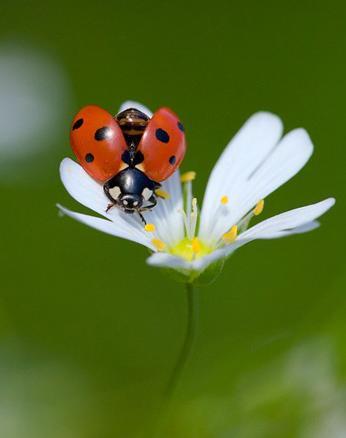
natali
they are so cool .... every time you rejoice when you see them))))
What other beneficial insects are there besides a ladybug?
And what is the benefit of ladybugs? OO - 3 years agosoldier1979
Very many, for example, spiders - destroy flies and mosquitoes, the same aphid, which absorbs the leaves and stems of useful plants, at the same time provides food to the ant. I can continue the list.
З В ЕЁ Н К А
In addition to coccinellids (“Ladybirds”), I know some more useful insects for humans and fruit orchards:
1 .Zlatoglazka (beautiful, right?). Willingly and with great appetite they destroy the aphids in the apple trees And it is very important that any spraying of aphids does not harm the gold-eyed.
2 .Trichogram (egg-eater). He eats eggs of moths and leaflets.
4 The telelenus. Eats eggs of fruit ringed silkworm.
5 Hoverfly.
6 Spider burglar.
7 .Earwig. It turns ears not to the person, do not be afraid, but to harmful caterpillars.
8
.Dragonfly. 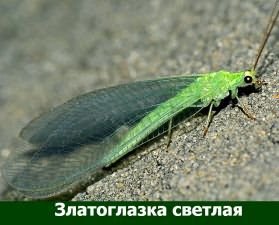
Tanya 84
I think no insect is healthier than a bee. She will bring you honey, you can talk about its benefits for a long time, and pollen and propolis. And how much benefit to other plants associated with pollination. And even after his death, the bee is beneficial. There are many effective recipes for bee infusions (dead, dry bees soaked with alcohol). You can also use several dry bees per day to lower blood sugar levels, it really helps, tested on my two mates.
A story about a ladybug for elementary school students
Khamidulina Almira Idrisovna.Place of employment and position: MBOU of the gymnasium "Christina", Tomsk, primary school teacher.
Purpose: acquaintance with the ladybug.
Tasks:explore the life of a ladybug, develop thinking, observation.
Purpose : this material will be useful for primary school teachers when conducting lessons of the outside world, lessons about nature in extracurricular activities, and also as material for conducting an excursion to the park.
The bug of the Virgin Mary is in Germany, the bird of Our Lady is in English-speaking countries, the hen of god is in France.
Guess? Today we will talk about an incredibly beautiful red bug, whose life span is about 2 years. His business card is light wings of bright red color with black dots.
We have called him a long time - ladybug. Of course, this sweet, kind creature cannot be called otherwise! At least, this impression remains after meeting the bug. Ladybirds live in all corners of the globe. More than 4,000 species are known!
Not all beetles have the same number of points. There are 22, and there is only one! The number of points remains unchanged throughout life. The most common ladybug with seven points cleans our gardens from aphids. It makes up to 85 strokes per second when it flies. She ... all the time in search of prey! More than a hundred aphids eats in one day. This glutton!
She easily finds aphids in large quantities on cabbage, apple, bird cherry, because often they stick around the whole plant, sucking the juice. A ladybug appears and eats them one after another. The toasts are very bad when the cows arrive. The wings and legs of the aphid are very weak — they cannot escape, nor can they fly away!
Also our spotted friend is a thunderstorm of spider mites, which a pair of ladybirds can destroy up to 4,000 in their lives.
Probably, this name was given to the beetle and in gratitude for the fact that it saves our green plantings from pests. Therefore, it is mistaken to consider it a herbivore, because in fact it is a predator, and even useful.
Why ladybug Birds, frogs do not eat them, because our cute bug releases poisonous yellow liquid from the joints of the legs. Moreover, it is also very foul-smelling, which is even fatal in large doses! Milk and bright ladybug outfit scares even tarantula spiders!
I think because of this ability to produce milk bugs and called cows.
Of course, not always ladybugs active. With the onset of cold weather, they hide under the bark of trees and under fallen leaves. So winter. Start flying only when food appears.
It is interesting to know that the ladybug is immortalized! An example of this is monuments in various parts of the world! And here are some of them:
Our - in Volgograd!
Class - Real insects
Squad - Beetles
Family - Сoccinellidae
Basic data:
DIMENSIONS
Length: 1.5-12 mm.
Colour: Shades of orange, red, yellow and black.
Reproduction
Mating period: spring and summer.
Number of testicles: from 3 to 300, depending on the type.
Incubation period: 5-8 days.
LIFE STYLE
Habits: ladybugs (see photo) winter in groups.
What feeds on: mostly aphids.
Lifespan: about a year.
RELATED SPECIES
About 80 types of ladybirds live in Central and Northern Europe.
There are many types of ladybirds. Most of them are painted in bright colors. Ladybirds feed on aphids, and this earned sympathy from farmers. Ladybirds have few enemies because they are rather unpleasant in taste.
DEVELOPMENT CYCLE
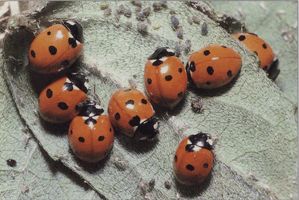 Most of the ladybirds breed in spring or autumn. Females of ladybirds, depending on the species, lay from 3 to 300 eggs. The testicles are laid near the colonies of aphids. Two-point ladybug testicular larvae usually develop within 5-8 days. The larva eats from 350 to 400 aphids daily and reaches maturity in 10-15 days. Then it turns into a pupa, and its cocoon hangs usually in well visible places.
Most of the ladybirds breed in spring or autumn. Females of ladybirds, depending on the species, lay from 3 to 300 eggs. The testicles are laid near the colonies of aphids. Two-point ladybug testicular larvae usually develop within 5-8 days. The larva eats from 350 to 400 aphids daily and reaches maturity in 10-15 days. Then it turns into a pupa, and its cocoon hangs usually in well visible places.
The conversion cycle lasts from 4 to 7 weeks. In the temperate zone, young and adult individuals hide for the winter in the cracks of the trees or under their bark.
Every few years, in the summer, the beaches are littered with seven-point ladybugs. This happens because they lack aphids. For this reason, they are forced to migrate in search of food. At this time, they are so hungry that they bite everyone - even people, to make sure they are not suitable for food.
LOCATION
![]() Ladybirds live all over the world, but are more common in the temperate zone - in Europe and North America. Relatively rare it can be found in tropical forests, where many other species of beetles live.
Ladybirds live all over the world, but are more common in the temperate zone - in Europe and North America. Relatively rare it can be found in tropical forests, where many other species of beetles live.
Most often, these insects live in an environment that has been altered by humans: in gardens, in forestry or in abandoned, weedy areas. In these territories, aphid is found in huge quantities, which is the main food of ladybirds. In addition to aphids, ladybugs feed on other insects: worms, whiteflies (aleurodids), spider mites, etc.
There are also species that feed exclusively on plants. In the UK, ladybirds are grown to protect gardens from aphids. On all continents they are bred to combat garden pests.
A good example of this is the Ladybug rhodium, brought from Australia to the United States to exterminate the insects (close relatives of the aphids) - insects that cause great harm to the citrus plantations there.
WHAT EATS
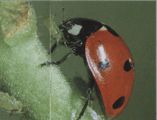 Most of the ladybirds feed mainly on aphids. Aphid is a soft-bodied, helpless insect that sucks sap from plants. Some types of ladybirds eat scabies mites that are harmful to plants.
Most of the ladybirds feed mainly on aphids. Aphid is a soft-bodied, helpless insect that sucks sap from plants. Some types of ladybirds eat scabies mites that are harmful to plants.
Aphids are slow and weak, so the cow doesn’t need special tools to hunt it. The larva of this beetle eats more than an adult individual, and with a lack of aphids, it can feed on other larvae. Jaws of the larvae are the same as in the adult.
WHERE MEET
Ladybirds can be found throughout the year (for example, if you dig up dry leaves, under which they hide during the cold season of the year), but you can see, without making any effort, only in spring, summer and early autumn. In winter, they hibernate. At this time of the year, whole groups of ladybirds are protected from the cold in secluded places, for example, under the bark of a tree. In the summer, they can most often be found on roses affected by aphids, sweet cherries and other garden plants. Carefully looking at the plants, you can see the testes of ladybirds. Ladybird larvae live openly on plants. In winter, among the needles of conifers, you can find a seven-point ladybug.
- The larva of a ladybug eats up to 90 adult insects and 3,000 larvae before reaching maturity.
- In Central Asia, there lives a miniature ladybug - a small black beetle, the length of which is only one and a half millimeters.
- All ladybugs have approximately the same shape - their bodies are round, strongly convex at the top and flat at the bottom.
- There is one type of hymenoptera that can eat the ladybird larvae from the inside.
- Cows are striped and monochrome - not everyone has a point. They differ in color, for example, a two-point ladybug can be red with black dots or vice versa, black with red dots.
CHARACTERISTIC FEATURES OF GOD OF GOD
These beetles are brightly colored, usually in black and red or black and yellow. Bright coloring is a warning to attackers about their inedibility.
When attacking it, the ladybug reacts by involuntary release of a caustic hemolymph - an orange liquid with an unpleasant odor. Hemolymph contains inedible compounds that scare off enemies, such as ants and birds.
The first pair of wings of a ladybug is formed by two hard shells - the so-called elytra, which protect the second pair of wings when the insect does not fly.

Where it lives
Distributed throughout the world, especially in temperate latitudes.
PROTECTION AND PRESERVATION
The number of ladybirds was greatly reduced when they began to destroy aphids with the help of chemicals, because this was the main source of their food. Nowadays, their numbers are recovering, since these insects have begun to be specially bred to fight against aphids.
Birth: ladybug, butterfly. Insects. Interesting video about animals №2. Video (00:04:40)
Ladybug benefit and harm. Video (00:04:59)
Is there any benefit from a ladybug. The main benefit of a ladybug on a plot is that it feeds on many insects harmful to cultivated plants.
Ladybug insect insects Coccinellidae. Video (00:01:50)
Larva of the Ladybird. Video with insects. Birth of the Ladybird. Video (00:00:57)
The benefits of a ladybug. Video (00:01:34)
The main benefit of a ladybug on a plot is that it feeds on many insects harmful to cultivated plants.
what is the benefit of a ladybug
benefit from a ladybug
what is the use of a ladybug
ladybug harm and benefit
what do ladybirds eat? Video (00:02:08)
Ladybug in the grass. Video with insects. Ladybug Video. Stocks for video editing. Video (00:00:52)
It is difficult to imagine a brighter summer symbol than the Ladybird crawling in the grass. A red bug in black dots against a background of green grass has been familiar to everyone since childhood. Red bugs come in all sorts of shapes and varieties, but the Ladybird is one of the most charming insects!
Here is a ladybug -
A useful bug!
See how cleverly
Crawling on a piece of paper!
How nicely dressed:
Pea row,
Orange color
Underline outfit!
She won't bite
But sometimes
Orange droplet
Splash on you.
Do not be afraid, because this -
her milk!
It will wash off with water
Very easy.
But with a drop
Luck will come
After all, Ladybug
Good luck bears!
The most common type of beetle with red elytra and a black dotted pattern is affectionately called the “ladybug”. It is difficult to find a person who would not hear about these insects, but how many people know about them?
The beauty of the ladybird can be compared with butterflies, and the most interesting thing is that they are born into almost the same way!
The birth of this insect takes not so little time: one or two months. This is called the life cycle. In a ladybug, it has four stages. It:
- egg stage,
- larva stage,
- pupa stage
- the stage of growing up is the final one.
Egg Stage
The first stage is the egg stage. Ladybug, laying eggs, trying to protect their offspring. For this, the female hides the eggs of future beetles on the reverse side of the leaves. So they are not visible to insects and other predators. An interesting feature is that the mother for her children is looking for a place where there are a lot of aphids so that after the birth they have food for the first time.
Larvae stage
And here passes one or two weeks, and the larvae hatch from the eggs, which means that the second stage has come. Ladybug larvae are quite mobile, have an enviable appetite, eating c infect eggs and their newly hatched larvae from the first minutes of life. This stage lasts about a month, during which time the larva reaches a centimeter in length.
The third stage of the pupa
Ladybug is fixed on the leaf of the plant. It turns into a motionless pupa, which hardens and acquires a brown color. She has a fairly strong shell, after a week and a half she will burst and a bug will appear.
Stage of maturation
The fourth stage comes along with the birth of the little beetle, which we affectionately call the "sun". Finally, we see our usual ladybird, which can now fly. And after waiting a little until her wings get stronger, she will disappear from your eyes in search of food.
Few people know how important these bugs are for vegetable gardens. The ladybug is a true protector of plants, it eats pests such as aphids and spider mites.
In the fall, ladybugs hide in secluded places to spend the winter. For example, under the bark, in the fallen leaves, in warm moss. In the spring, when everything will flourish, they will reappear and will delight with their bright outfit.
However, not everyone is going through wintering, so it is generally accepted that on average a ladybug lives from 10 to 12 months, although in reality the life cycle can last up to one and a half years.
Ladybugs are small and beautiful brightly colored beetles. In different countries they are called differently. For example, in Ukraine this insect is called the “sun”, in Great Britain - the “lady bug”, and in France - just like in Russia, i.e. "ladybug".
Instruction
Ladybugs are truly lovely creatures. They belong to the beetle family. With their appearance, bizarre motleyness and coloring, memorable at first sight, they have attracted the attention and interest of people since ancient times. In some countries, many different ancient superstitions and legends, fairy tales and proverbs are generally associated with ladybirds. For example, one of the legends says that a ladybug, sitting on the palm of a person, brings good luck. In addition, these insects bring good luck and peace and to those people in the gardens or dachas of which they settle.
The body of a ladybug is ovoid or hemispherical in shape. The head of this insect is very short, and the entire abdomen consists of five free segments. Ladybirds differ from other beetles in that their paws at first glance seem to be three-segmented, but this is far from the case. The fact is that the third (smallest) segment is hidden in the furrow of the bilobate second segment, along with half of the fourth. These cute beetles are easily recognizable by their specific bright red or orange color of corpuscles with noticeable black dots. Beetles with such coloring are called seven-point ladybugs and are the most common species in the world. It is worth noting that entomologists call “cows” of all beetles, whose backs are covered with dots, commas, a dash, or even letters “m”.
Such a bright color of the ladybirds is nothing more than a warning factor, because the bright colors inherent in one or another animal help them to defend themselves against enemies. In other words, a bright color ladybird warns of its inedibility. For example, if you catch this insect, and then slightly squeeze it with your fingers, it will squeeze out a drop of orange liquid. This poison is cantharidin. He is not afraid of man, but the bird that grabs the ladybird will burn his throat, and another time the bird will not even look in the direction of this insect. With such a protective coloration, the ladybirds have almost nothing to fear. It is curious that other beetles are disguised as ladybirds in the hope that the birds will not touch them either.
Ladybugs bring people invaluable benefits: they eat aphids, so the second name of these beetles is “bodyworms”. In addition to aphids, ladybugs and their larvae destroy such pests as scale insects, worms, spider mites, larvae of leaf beetles, small caterpillars, as well as various clutches of insects and other pests of agriculture. It is worth noting that the appetite for ladybirds is enviable and excellent! For example, to eat, one individual needs up to 50 aphids a day! By the way, not all ladybirds are decorated with black or red spots. Among them are those that have a yellow coloring with black dots or black coloring with red dots. Occasionally you can see a white ladybird - this is a very young insect, recently hatched from the pupa.
Moms know how difficult it is sometimes to get a child to eat. In such cases, come to the aid of funny sandwiches that will surely interest your kid. In addition, you can involve him in the cooking process and thereby develop creative abilities.

You will need
- - 1 scone sandwich;
- - 1 slice of cheese;
- - 1 slice of doctor's sausage;
- - pitted olives;
- - butter;
- - a sprig of dill.
Instruction
Cut the bun in half to make a hamburger. Grease one half of the buns with butter. Top lay a slice of sausage.
The second half of the bun is cut into three parts to make the head of a ladybug and two wings. We put the resulting parts on the bottom bun.
Next, go to the design. To make paws, we need cheese. Just cut it into 6 vertical slices and put it on the lower part of the loaf with 3 legs on each side. In order to make eyes, it is necessary to cut two small circles out of cheese and attach them to the upper part of the loaf, where the head will be.
Go to the olives. Cut off a small piece to make a nose for a ladybug. The remaining olives are cut into thin rings and laid on the top bun for decoration. The sandwich is ready. If you want to add more details, you can make the antennae of the fennel twigs and attach them over the eyes of a ladybug.
Related videos
For a large feast simply needed snacks. You can cook them from anything. Even the most common sandwich can turn into a snack and diversify the table. Ingredients will need the most ordinary - those that are always on hand. Decorating such a sandwich somehow in a special way will turn it into a real table decoration.
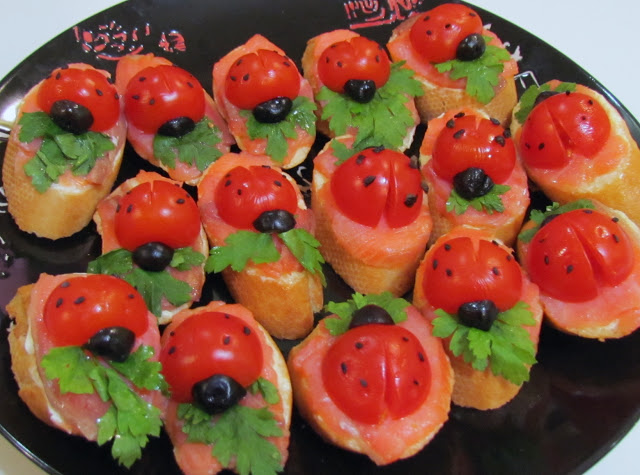
You will need
- - French loaf
- - red salted fish (salmon, trout or pink salmon)
- - butter
- - Cherry tomatoes"
- - black olives without stones
- - parsley for decoration
Instruction
Cut into a loaf of 1 cm thick. We spread each slice with butter, and put a slice of red fish on top.
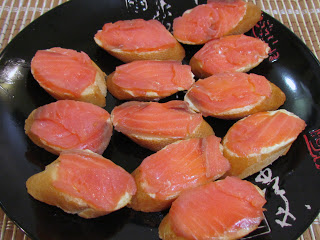
Beautiful and bright salad with a rich savory taste. Pleasantly diversifies the festive menu and will delight guests. The salad is made in the form of a ladybug, the back can be made of red pomegranate or finely chopped red sweet pepper, it all depends on your preferences.
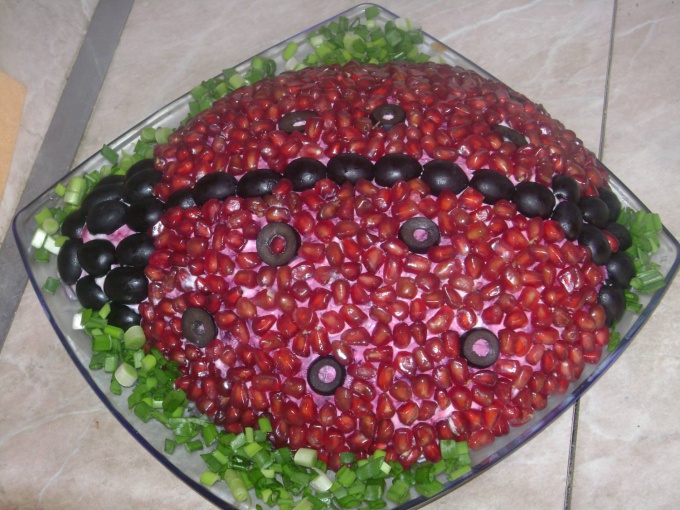
You will need
- - 5 pieces. potato;
- - 350 g chicken fillet;
- - 4 things. chicken eggs;
- - 2 pcs. medium beets;
- - 100 g of mayonnaise;
- - 1 PC. large red pomegranate (or pepper);
- - 10 pieces. canned pitted olives;
- - 100 g of green onions;
- - salt to taste.


